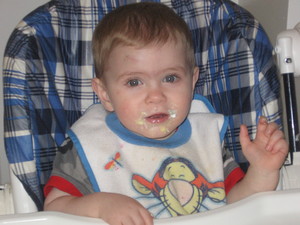My son, Xander, is currently being treated for his multi-dimensional eating issues related to his form of SPD. First of all, Xander has weak muscles in his mouth and jaw which not only prevents him from chewing his food effectively but causes him to avoid any foods that are too chewy, crunchy or that need him to use a more rotary-style form of chewing, such as what you’d do when eating meat-using the back part of the teeth and mouth. Next, because Xander needs a tremendous amount of sensation in his mouth to ‘feel’ his food, he stuffs everything in there until he’s gagging on it. And finally, Xander has a very high gag reflex. What this means is that where typical children move slowly from liquids to mushy to lumpy to pieces to regular mouth-friendly proportioned foods, Xander never moved past mushy.
When Xander sits down to a meal, he can get the food up to his mouth but his tongue works against him in moving the food around properly in his mouth for chewing; his chewing motor skills are poor and his brain isn’t giving his mouth the signal to chew his food properly; his brain also isn’t sending the signals to tell him when his mouth has enough in it or that it needs to chew before putting more in there; and, finally, because he has never been able to learn to tolerate lumpier foods, his gag reflex kicks in as if to say, “Quick! Get this out of here! Danger! Alert!” These issues may also contribute to his speech delays.
Eating is a multi-step skill. Our OT has taught me that there are many steps involved in helping a child like Xander ‘learn’ to eat. It’s not as simple as putting the food on his plate and saying, “EAT!” We literally have to teach him the mechanics of eating from tolerating on his plate to keeping it in his mouth to teaching him what to do with it once it’s in his mouth and all the tiny steps up to swallowing.
First step: Finding and strengthening the ‘reflexogenic zone’. The first area we were helping Xander with is his highly reactive gag reflex. If we can push back his reflexogenic zone (the area that triggers the gagging, which at the beginning of our journey was right in the front of his mouth), we can then work on what to do with the food in his mouth. For most of us, the reflexogenic zone is right at the back of the mouth. This is where we want it to be for Xander so he won’t gag and throw up when he simply puts food with a texture heavier than apple sauce.
The Tongue Jumping Game. We learned a great gag desensitization activity from our group of OTs that we call, “The Tongue Jumping Game. To get started, you have to find your child’s gag zone so you know where to begin and move past from. Start by using your finger, the base of a kiddie toothbrush, spoon or toy and press firmly on the front of your child’s tongue. (This may be a challenge for a child whose gag sensitivity is so high he gags just having you near his mouth. If that’s the situation for your child, begin this activity just outside his mouth.) This is the area you’d do the activity in, moving back just a tiny bit each time as tolerated.
Once you find this spot, ‘jump’ with your finger (or whichever of the above suggestions you choose to use) in that spot up to 10 times. The point of this exercise is to push the gag-sensitive area to the back ¼ of the tongue. It takes a long time so be patient and never force it as this may only make you have to start back at ground zero again.
Important: Many children will also have the tactile issue in addition to the above-mentioned struggles. Be sure you use the right amount of pressure on his tongue or he’ll gag simply from the lighter touch. Don’t worry! He’ll let you know if it’s too light or hard by his reaction. (Xander’s whole body relaxes when he’s given the right pressure or touch.)
Additional tips in practicing the activity. Here are some tips while doing the activity: (1) Use music or say a rhyme while you’re ‘jumping’ on his tongue to set a rhythm and predictability. This also makes the activity focused more on fun rather than an icky exercise that’s going to make her gag; (2) ‘Jump’ on your tongue at the same time or get your child to do your tongue while you do his. Then he won’t feel ‘singled-out’; (3) As stated earlier, if gagging happens even before you touch the tongue, start on the cheeks, jaw, chin or lips then gradually move into the mouth. Baby steps is still a step; (4) Our OT suggests a ‘gag distraction’, which is using a favorite toy, activity, song, book or other tools to distract. This helps the child learn to control his gagging on his own without a lot of attention being paid to the gagging; (5) If there is a lot of gagging, it can be controlled by having your child move his head down so that his chin pushes on his chest. You can increase this flex by pressing on the sternum of the chest with your hand. Essentially, this position makes gagging uncomfortable and anatomically difficult. It also helps your child learn to stop his gagging before the point of throwing up.
The most important thing to do while doing this exercise is to give tons of praise and positive feedback. As with any exercise we do with our ‘sensational’ child, it will be uncomfortable and, possibly, scary for her at first. After all, we’re introducing her to sensations she’s actively avoided due to how they make her body feel. But after while, with your love, support and guidance, her brain will make the neural connections to understanding the sensations and it will become automatic.







